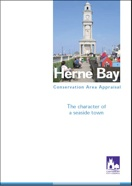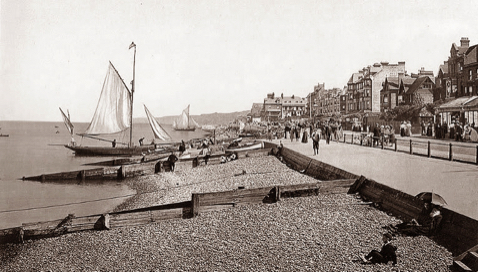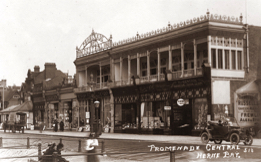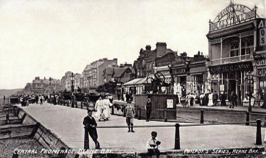Herne Bay
house History
Central Parade 1903 (Then known as Marine Parade)
The Burrs can be seen in the top right hand corner
The Burrs stands at the western end of Central Parade between the Ship Inn and William Street, part of the the ‘Old Town’ of Herne Bay. Development of the area began around 1814, after the Napoleonic war, when the road from Canterbury was turnpiked and extended to the seashore with a new road, East Street, at the side of the Inn.
Prior to 1814, Herne Bay was primarily a fishing and farming village, but as early as 1771 visitors had started to be attracted to the area for its bathing facilities. In June of that year a Mr John Devon advertised his bathing machine service:
It wasn't until Napoleon's threat of invasion had passed that the development of Herne Bay began in earnest. The village had catered for military personnel, and therefore was well placed to cater for visitors when the army left.
In 1814, Sir Henry Oxenden, of Underdown and Sea Street Farms, owned all the seaward part of Herne Parish from the new East Street to Sea Street, and he laid out a small grid of narrow streets on part of this land and sold plots for development around this time. The small terrace on the west side of East Street is among the earliest of the houses built on these plots from about 1816, while on a superior scale, four tall terrace houses on the top of the slope facing the sea date from the same period. The legend that these were built as officers quarters, or for French prisoners of war, seems to have no basis of fact.
In 1825 George Randall of King’s Cross, London, acquired most of the land adjoining this terrace as far as William Street, apart from a plot already sold to Thomas Cooper of Canterbury (now 36 Central Parade) flanked by Cooper’s Hill, the seaward extension of Underdown (now Bank) Street.
Randall built five bow-fronted Regency style houses next to Cooper’s house, and this Marine Terrace was completed by joining these to the earlier terrace after1832.
West of Cooper’s Hill one house was built in about the position of May Lodge, but apart from this the section to William Street remained undeveloped during the greater part of the century, until the 1880’s.
Stapleton's Directory of 1838 describes Herne Bay as being:
'This delightful and rapidly improving watering-place. The salubrity of the air has almost become proverbial, and therefore forms one of its chief sources of attraction'.
At the end of the directory are some very amusing advertisements using the quaint flowery language of the time.
The First 102 Years 1884 - 1986
The Burrs first appears in the Herne Bay rate books in July 1884. There is no trace of it in the April volume and the July entry is located at the end of the book as newly rated property. In the October volume it is listed among properties in Charles Street, along with May Lodge, the Vicarage and Sidney House, though none is actually named as such.
We don’t know how the house came into being although there must be archival records yet to be discovered. The years 1880-1889 were peak years for building in Herne Bay, with over 250 new buildings being constructed. This suggests that new money was coming into the town from outside, almost certainly from London. Medical professionals at the time were extolling the virtues of escaping the pollution and smog of our cities to the cleaner, fresher, more embracing air of our seaside resorts such as Herne Bay, Margate and Broadstairs.
The Burrs could have been a speculative build by a local developer, or it might have been built by its first owner and occupier George Phillips. The architecture of the building, quite unique to Herne Bay, rather suggests that it was built by an out of towner. We know that the rental value, on which the rate was based, was estimated at £75, as compared with, for example, the neighbouring Sydney House (No.45) which had a rental value of £40.5.0.
There doesn’t seem to be any local records of the Phillips family before The Burrs was built, further evidence that the family came from outside Herne Bay. The 1881 census shows a Phillips family living in London who have a son, Arthur, who was born in Herne Bay and who’s father is George. Could this possibly be our George Phillips. It lists George Phillips aged 57, wife Annie 55, and children Alfred 7, Florence 5 and Arthur 8 months. So the family were definitely in Herne Bay in 1880 for Arthur’s birth. The 1881 census suggests that they were a comfortably off middle class family, well able to afford a house such as The Burrs. George Phillips has no occupation listed in the census but they were living in a flat in a very upmarket mansion block in Elm Tree Road in St John’s Wood. They had two servants, a cook and a nanny. One of their immediate neighbours is listed as a barrister.
We have found several references to George Phillips in the local press. In an article in the Whitstable-on-Sea Times dated 25 Oct 1884 it says that he successfully appealed against The Burrs rate assessment and had it reduced from £60 to £50. In further articles it was reported that in October 1884 he gave a valuable mantelpiece clock made by Bennett of London to the local Conservative Club at Bank House in William Street, and in April 1887 Mrs Phillips displayed her very beautiful collection of mechanical toys at the new Wesleyan Chapel in the High Street.
Mrs Phillips is actually listed as a subscriber living at The Burrs in the Rev Buchanan’s book ‘Memorials of Herne’ published in 1887. However in the 21 Jan 1888 edition of the Whitstable Times & Herne Bay Herald it was announced that George Phillips died suddenly at his London residence. His death was described as pneumonia brought on by the recent fogs. So clearly the Phillips family split their time between St John's Wood and Herne Bay. Available directories show Mrs Phillips as being the occupier of The Burrs in 1889.
The 1891 census shows the Phillips children to be back in London, living in Cambridge Gardens, Kensington. They are listed as step-children but there is no mention of Annie Phillips. The head of the household is James McVeigh a retired stockbroker, so perhaps he adopted the children on Annie Phillips death.
Strangely the 1891 census for Herne Bay doesn’t list The Burrs. In the 1892 directory the name of the occupier is C Dalziel. This could well be Charles Dalziel. It’s too much of a coincidence that his uncle, Thomas Dalziel, lived not too far from The Burrs at Wooler House in Beltinge Road. Charles and Thomas were members of the famous engraving and printing family known as the Dalziel Brothers. Charles was involved with the family printing business in London, the Camden Press, and was probably visiting Herne Bay to enjoy the resort and to see his uncle and cousins. There probably wouldn’t have been room for him, and possibly his family, to stay at Wooler House because the 1891 Census lists 8 members of the Dalziel family and 2 servants living in a relatively modest sized 5 bedroom house. The house is still there today with the name Wooler House above the front entrance. Charles Dalziel was born in 1858 and would have been about 34 when he visited Herne Bay 1892. He died aged 80 in 1938 and was buried in Old Highgate Cemetery, as was Thomas who died in 1906 at the age of 83.
In 1893 The Burrs was empty, and in 1894 was advertised in the London Standard as being up for auction on 30 April at The Mart, Tokenhouse Yard, EC. The auctioneers, Messrs HS Hawley were acting by order of the Executors and Trustees which suggests that Mrs Phillips had died. The auction details were as follows:
Herne Bay. With Possession. The well-built Freehold Residence, known as The Burrs, The Parade, Herne Bay, pleasantly situate facing the sea, and within 15 minutes walk of the railway station; the house is of imposing elevation, is substantially built in red brick, and contains the following well-arranged accommodation, viz, six bed-rooms, fitted bath-room, three handsome reception-rooms, billiard-room, kitchen, and well-arranged offices: garden front and rear: the estimated rental value is £75 per annum.
From 1895 to 1899 the occupier’s name was WB Faulkner so it would appear that he was the new owner. In 1900 and 1901 a Miss Ross appears, followed in 1902 by Miss Goss (these may be the same person as the names are very similar), in 1903 by Countess Durham, and in 1904 by Miss Studdert. The 1901 Census shows the house to be occupied by just two servants, suggesting that the house may have been let on a seasonal basis and there were no guests resident at the time.
The 1911 Census definitely shows the Faulkners to be in occupation. The head of the household is William Faulkner 68, his wife Ellen 65, grand-daughter Mabel Willson 14, a cook and two housemaids. William Faulkner is listed as a retired tobacco manufacturer, and from a press article announcing the marriage of his daughter to a Mr William Willson in October 1895 we gather that the Faulkner family split their time between Wimbledon and Herne Bay. The Faulkner family business, run by William and his brother Frederick, known as W&F Faulkner was based in Blackfriars, London, and was famous for its 'Ye Black Friars' cigars, 'Grenadier' cigarettes, and the 'Nosegay' and 'Tom Long' brands of loose tobacco. Eventually the business was taken over by the Imperial Tobacco Company.
William Faulkner died at the age of 69 the year following the 1911 Census. We know from the 27 April 1912 edition of the Whitstable Times & Herne Bay Herald that he had passed away leaving an estate of £227,000 - about £25 million at today's value.
In the 1917/18 Blue Book directory the name of Mrs Faulkner appears, so probably the house remained in Faulkner ownership. At this point in time the Parade is still known as Marine Parade rather than Central Parade, and the house is listed under the name 'The Burrs' with ’The Manse' (No.43) on one side and 'Sydney House' (No.45) on the other, forming a terrace of three houses. Evidence indicates that the three buildings forming the terrace were not all built at the same time. Sydney house was built long before The Burrs. We've found announcements in The Morning Advertiser of Feb 1872 of the death at Sydney House of Lydia Allan from Camberwell, and the birth of a son to Mrs Edward Boyle also at the house in The Pall Mall Gazette of Oct 1877. Therefore Sydney House was built sometime prior to 1872 and The Manse may also predate The Burrs which explains why The Burrs is so different in style to the adjoining houses in the terrace.
The next house along, standing on the corner of Marine Parade and William Street is listed as 'The Royal Hotel' (No.46). The house was originally called 'The Lodge' when it was built in 1867. When its owner, Dr Alfred Rawlings, retired at the turn of the century it became the 'Royal Hotel', and then in 1972 'The Bun Penny' pub. As we know from more recent events, the building was gutted by fire in 2011 and a new apartment building erected in its place.
In the 1920 directory The Burrs is empty, in 1927 Mrs Williams is named, in 1935 HWB Griffin, in 1939 Mrs Maclean, and in 1940 there are three names, Mrs Marcus-Alwynne, Mrs J Clinton Collins and Mrs Maclean. We know that Mrs Williams owned The Burrs in 1930. It was reported in the 9 Aug 1930 edition of The Whitstable Times & Herne Bay Herald that a servant had purloined a number of personal items belonging to Mrs Mary Williams the proprietor of The Burrs and her daughter Eileen Collins. At the St Augustine's Petty Sessions in Canterbury the items were listed as two cameras, a powder bowl, one paste brooch, three pairs of earings, one string of artificial pearls, aluminium shoe trees, a quantity of ribbon, a scarf, a silk sash, a hankerchief sachet, a black silk coat, a black silk dressing gown, a red georgette evening dress and a purse. Apparently all the items were found in the servant's room at The Burrs.
Mary Williams was described as a widow at this time, and so far we have no information about Mr Williams. We know that Mrs Williams' daughter Eileen had the surname Clinton, and later became Mrs Clinton-Collins. In 1931 The Whitstable Times & Tankerton Press reported that she had problems with the authorities over her car insurance, and in 1933 parking in Canterbury with no lights.
The 1939 Register compiled at the start of WW2 placed Edith Maclean and Edith Marcus-Alwynne at The Burrs. Both are listed as widows with independant means. Three other females are also listed - a mother and daughter by the name of Keeble, and a Phyllis Desmond, all of whom are carrying out unpaid domestic duties. We know that Edith Marcus-Alwynne was a leading member of the Canterbury branch of the National Citizens Union, and from newspaper reports we know that she had much to say at meetings about the pricing of electricity, Council refuse collections, road repairs, and railway services. She was obviously a very assertive and well educated women.
Very little is known about the house in the intervening years from 1940 until it was used as a location for the BBC series ‘Cockles’ in 1984, although The Burrs is mentioned in the 11 May 1946 edition of the Whitstable and Herne Bay Times. The report said that a Lieutenant Commander Claude Loscombe Collins de Guerin RNR, aged 62, had visited his estranged wife at The Burrs on 12 April and then subsequently committed suicide at his home in Cavendish Road. Was he the husband of Eileen Clinton-Collins?
Edith Maclean may have continued to live at The Burrs until her death in 1954, although Edith Marcus-Alwynne must have moved to Newton Abbot in Devon where her death was registered in 1948.
In 1986 a local development company, Janus Developments, acquired the property and converted it to five self-contained flats, one to each floor. Janus Developments was run by two partners, Ronald Cowley and Janelle Allison. On completion of the conversion Janelle occupied the Garden Flat and Janus sold the other four flats on 99 year leases. Around 1990 Janelle sold her flat and Janus sold the freehold to David Cannon Properties Ltd based in Mill Hill, London.
But mystery still remains as to why the house was given the name ‘The Burrs’. Our theory is that The Burrs refers to the highly prised grain formation found in elm wood called burr elm rather than to those clingy seed pods commonly associated with the word. If George Phillips was indeed the builder of The Burrs then he may well have thought it a good idea to give the house a name that reminded him of the elm trees that lined his road in St John’s Wood in London, Elm Tree Road.
Note: References to newspaper articles have been obtained from the British Newspaper Archive (www.britishnewspaperarchive.co.uk)
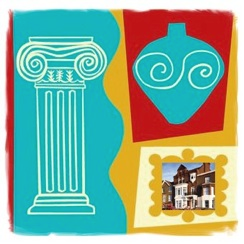
HISTORY
Canterbury Council's Conservation Appraisal gives a comprehensive account of the historical development and architecture of Herne Bay
Extract from 1917-18 Blue Book Directory
For BATHING in the SEA at HEARN BAY.
THIS is to acquaint all Gentlemen, Ladies, and Others, That we have now begun to bathe in the Water for this Season with the Machine. Any Person that requires the Benefit of the Waters, by coming to HEARN aforesaid, will be well attended, and proper Care taken of them, as we have provided a very sober careful Man for a Waiter.
Stapleton History & Directory 1838 - Herne Bay Extract
